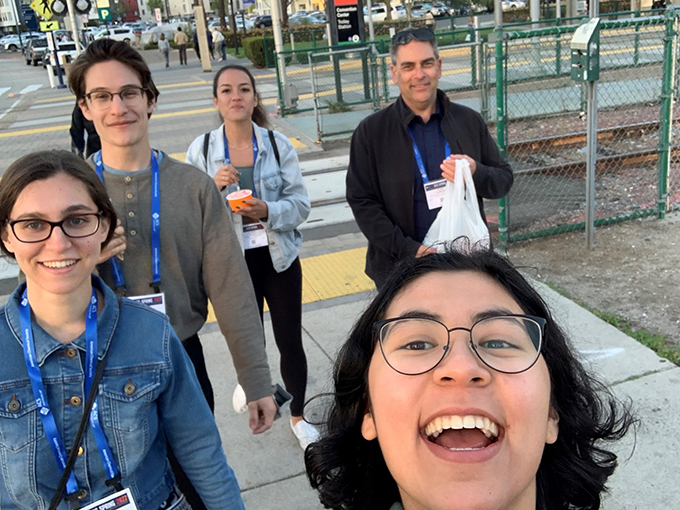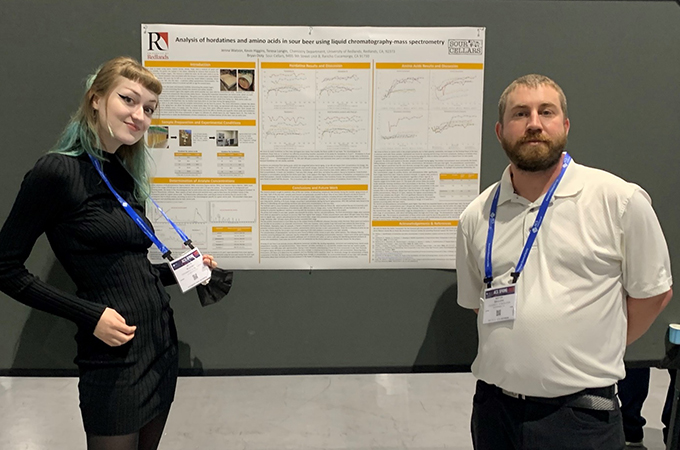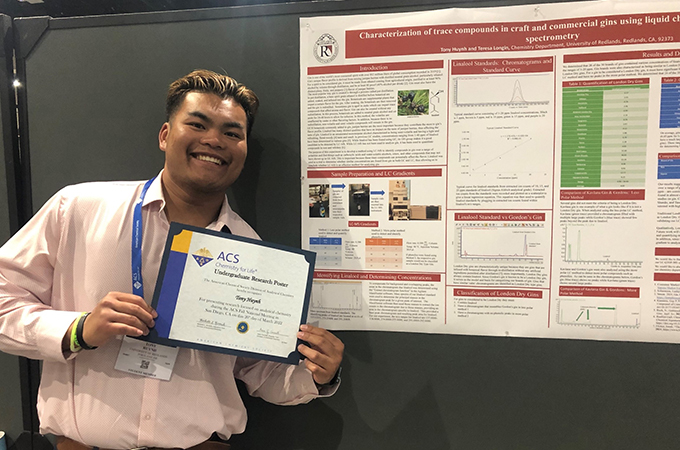How can anxiety and depression be treated with natural therapies? Can a model be developed to track pollutants in glacier meltwater? How are certain molecules in gin characterized? These are some of the questions University of Redlands chemistry students asked in their capstone research projects. In March, a group of these students and their faculty mentors attended the American Chemical Society (ACS) Conference in San Diego to present their findings.
“The ACS conference is a large conference where faculty, post-docs, graduate, and undergraduate students from across the world come to share the results of their scholarship and connect with other researchers,” said Professor of Chemistry David Soulsby.
A nonprofit scientific organization founded in 1876, the ACS aims to improve people’s lives through the transforming power of chemistry while championing the discipline and its practitioners. The organization’s biannual conferences address topics from sustainability in a changing world to harnessing the power of data. The most recent event focused on bonding through chemistry and featured more than 11,000 papers and presentations.
“As students and faculty members, we get to share our great work with that global audience,” Soulsby said. “Our students also get to connect with fellow researchers from other institutions, exchange ideas, and make important connections for future collaborations.”
Facilitating independent research
During their junior year, chemistry students interview faculty members and identify the topics of their capstone research projects. Under Professor Rebecca Lyons’ guidance, Summer Brown ’22 and Shaun Weatherly ’22 worked together to study how nonylphenol travels in glacier meltwater.
“Students come in not knowing what they are capable of,” Lyons said. “Through the research process, they develop critical thinking skills and begin to trust their evaluations. The only things required are enthusiasm and perseverance, and Shaun and Summer have plenty of both.”
An endocrine-disrupting compound that mimics estrogen in the human body, nonylphenol has been linked to testicular, breast, and endometrial cancer. The pollutant comes downstream into the water supply, which poses a problem, as Los Angeles County sources a significant portion of its water from that area.
For Brown, a lifelong passion for the environment evolved into an interest in environmental chemistry. Weatherly focused on developing the mathematical models that were needed for their research. Both are planning to attend graduate school in the fall; Brown noted that collaborating on research as undergraduate students will aid both of their future academic pursuits.
“[Professor Lyons] has an excellent mentoring style—she gives students a lot of independence to navigate their way through literature and experiments, but she’s always there to lend a helping hand. I know I’ll encounter that dynamic frequently at the graduate level. It was really useful for Shaun and me to develop those independent thinking skills to become better scientists,” Brown said.
Similarly, Tony Huynh ’22 appreciated Professor Teresa Longin’s mentorship as he navigated his capstone project, which used an analytical chemistry method to identify and quantify compounds in commercial and craft gin.
“Her constant support, positive energy, and excitement are infectious,” he said. “Having her as my research mentor taught me many skills: learning to research independently through data analysis or literature mining, how to work efficiently, how to give a good presentation, and learning that not knowing everything all the time is okay.”
The faculty-student mentorship experience is symbiotic. As a result of granting students independence, the professors witness students’ growth over time. “What I love, particularly about research, is watching students grow into independent chemists as they begin to understand their project, their methods, and their results,” Longin said. “I love watching them begin to take ownership of their work and their enthusiasm for their research project as they make it their own.”

Exploring beyond the classroom
The conference was a success in more ways than one. Eight students presented on various research topics; Soulsby says their talks were all well attended.
“It was rewarding to see how many people were interested in our students and faculty's research at the University. Our in-depth curriculum, hands-on experiences, and cutting-edge instrumentation—all of which culminate in the research capstone experience—give our students all the tools they need to be successful, at this conference or in their future careers,” he said.
Brown noted that the conference was the best three days of her life. She recalled meeting a woman who worked in polymer chemistry at the University of Washington—a career path she’s interested in traversing. “The ability to see all this research in one place and collaborate with people in different disciplines from different institutions was incredible,” she said.

The experience of presenting to fellow students in Hedco or Gregory Hall on the main Redlands campus was multiplied tenfold at the conference. The change in environment was a welcome challenge for many of the students, including Kevin Higgins ’22, whose project analyzed molecules found in sour beer.
“Being able to answer peoples’ questions about our project was the coolest part,” he said. “I knew I had theoretical knowledge but being able to do the research and talk about it with people outside the University prepared me for real life. I could be doing these things for a paycheck in a month or two.”
Faculty members appreciated that the students were enjoying themselves. “I loved watching my students interact with other chemists,” Longin said. “When people stopped to ask about the posters, the students lit up as they explained their work and results. They showed themselves to be confident, articulate, and engaged.”
All the student presenters will graduate this year and have been accepted for internships, graduate or professional schools, or will be applying for jobs in the field. Huynh, who recently committed to attend a doctoral program for physical therapy in the fall, called the opportunity to complete an independent research project and attend the conference a “once-in-a-lifetime” experience and hopes future chemistry students take advantage of it.
Brown agreed that the foundation she laid at Redlands will help her launch a career. “Some people don’t get to do independent research or submit abstracts to conferences until they’re years into graduate school,” she said. “The academic pace and mentorship at Redlands set students up for success.”
Learn more about studying chemistry or other subjects at the U of R.






